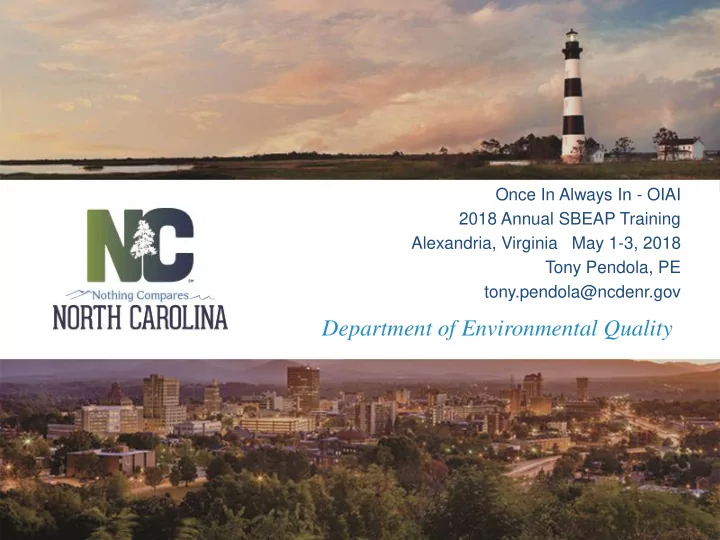

Once In Always In - OIAI 2018 Annual SBEAP Training Alexandria, Virginia May 1-3, 2018 Tony Pendola, PE tony.pendola@ncdenr.gov Department of Environmental Quality
Once In Always In Department of Environmental Quality 2
What We Will Cover • Definition • History • Arguments Against • NC Shot At Removal • Superseding Guidance • Complications • Audience Participation Department of Environmental Quality 3
Once In Always In Policy Defined John Seitz Memo – May 16, 1995 Potential to Emit for MACT Standards -- Guidance on Timing Issues “EPA is today clarifying that facilities that are major sources for HAPs on the "first compliance date" are required to comply permanently with the MACT standard” https://www.epa.gov/sites/production/files/2015-08/documents/pteguid.pdf Department of Environmental Quality 4
Once In Always In Policy Cont’d “… sources should not be allowed to avoid compliance with a standard after the compliance date, even through a reduction in potential to emit.” “EPA plans to follow this guidance memorandum with rulemaking actions to address these issues.” Department of Environmental Quality 5
Department of Environmental Quality 6
The Preeminent Disputation Department of Environmental Quality 7
Arguments Against OIAI • No regulatory basis •Contradicts “major source” definition • No temporal component • No rulemaking pursued • 112(j) MACT Hammer proposal changed to allow backsliding • Discourages emission reductions • Problems with Proposed Pollution Prevention Department of Environmental Quality 8
OIAI P2 Option Proposed Rules • EPA Proposed rulemaking on two occasions to modify a policy • 68 FR 26249; May 15, 2003 • Eliminate ALL HAPs • P2 Alternative Compliance Requirements • and 72 FR 69; January 3, 2007 • Admits to many past mistakes • Restores EPA’s faith in States and facilities Department of Environmental Quality 9
NC Boat Builder OIAI Case Heard from an old client that I was a “Doer” & wondered if I could find him some relief Title V Synthetic Minor w/ MACT Synthetic Minor w/out MACT like a greenfield Department of Environmental Quality 10
OIAI funeral dirge could be heard last year • Different Applicability Determinations • Complete removal now allowed • NC pulled a brick out of the wall • Future EPA Officials had OIAI in their sights (You’ll meet him Thursday) Department of Environmental Quality 11
Our Comments on OIAI Many facilities (autobody shops, printers, small spray coaters, etc.) have the potential- to-emit (PTE) hazardous air pollutants (HAPs) above major source thresholds, but have small actual emissions. Under EPA’s OIAI policy, a facility covered by a MACT standard under 112(d) of the Clean Air Act that does not obtain a federally enforceable state operating permit limiting its operations below the major source level, must obtain a complex, costly, and stringent Title V permit. Furthermore, this option is only available during a very short window of time following the beginning of the rulemaking and before the first substantive compliance date. The OIAI policy creates a competitive disadvantage for these facilities when compared to an exact duplicate greenfield (new) facility. This results in a lifetime punitive sentence on the affected business that never actually exceeded emission limitations contained in the regulations. Many small businesses were erroneously permitted as affected sources under a MACT. Many more reduced their HAP emissions below MACT thresholds, or even completely eliminated the equipment or materials containing HAPs. But all of these businesses must, under the OIAI policy, continue to demonstrate compliance with the regulations. This usually entails very complex recordkeeping and annual certification, at a minimum. In addition, current policy does not provide an incentive for reducing air emissions once the threshold that triggers applicability is reached. Changing this policy — to allow for businesses that makes process changes that permanently reduce their emissions — to fall to a lower regulatory tier would — 1. provide incentive for businesses to make capital investment to pursue those changes; 2. reduce the regulatory impact, particularly in the form of recordkeeping and reporting; 3. spur innovation in seeking out new and different processes that ultimately result in lower emissions from the business; and 4. make measurable improvements in air quality. 12
Association of Air Pollution Control Agencies 13
14
Anybody Suing?... SURE • Petition For Review et al. 15
Emissions Will Go (Down or Up) 16
Complications • Fees • Timing • Unintended Consequences • • • • 17
Once In Always In - OIAI 2018 Annual SBEAP Training Alexandria, Virginia May 1-3, 2018 Tony Pendola, PE tony.pendola@ncdenr.gov Department of Environmental Quality
Recommend
More recommend